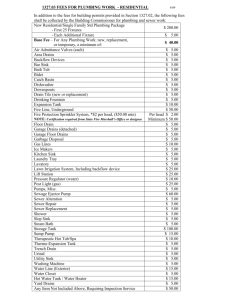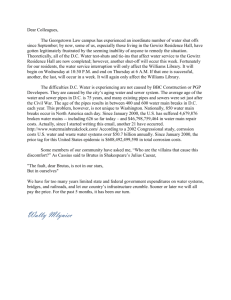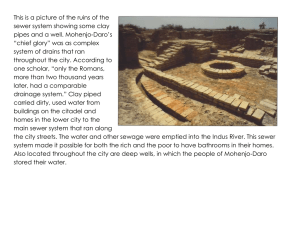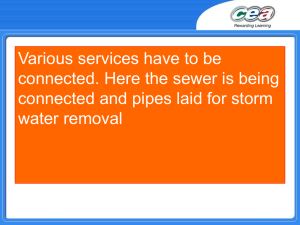Why Do I Have Sewer Smells In My Home or Business?
advertisement
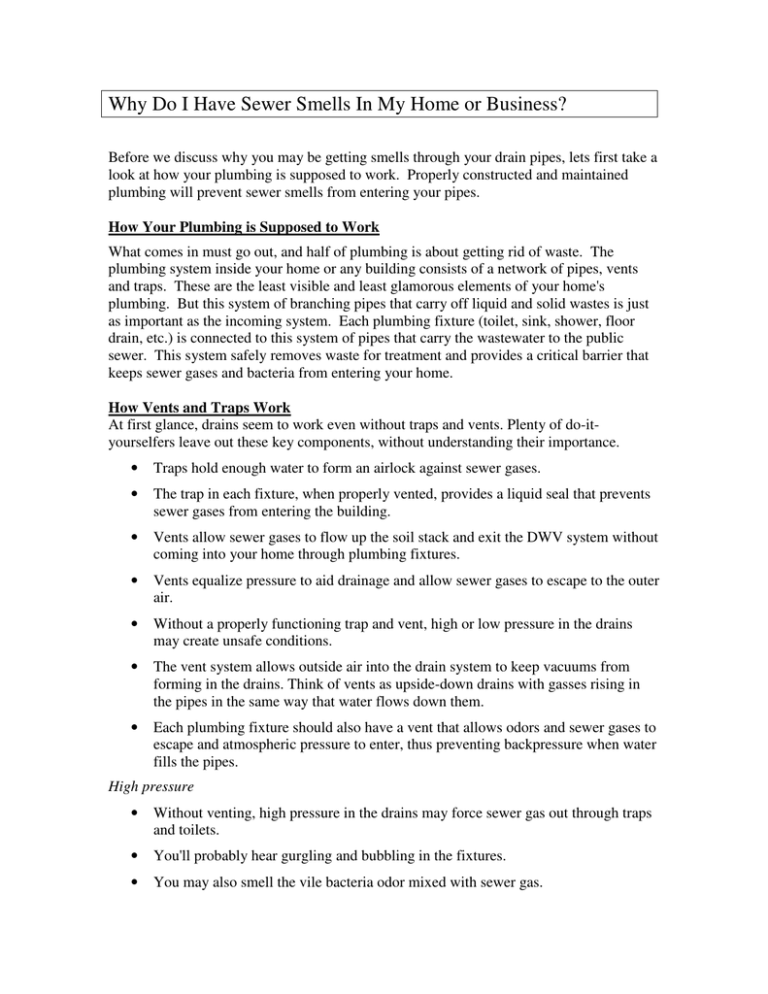
Why Do I Have Sewer Smells In My Home or Business? Before we discuss why you may be getting smells through your drain pipes, lets first take a look at how your plumbing is supposed to work. Properly constructed and maintained plumbing will prevent sewer smells from entering your pipes. How Your Plumbing is Supposed to Work What comes in must go out, and half of plumbing is about getting rid of waste. The plumbing system inside your home or any building consists of a network of pipes, vents and traps. These are the least visible and least glamorous elements of your home's plumbing. But this system of branching pipes that carry off liquid and solid wastes is just as important as the incoming system. Each plumbing fixture (toilet, sink, shower, floor drain, etc.) is connected to this system of pipes that carry the wastewater to the public sewer. This system safely removes waste for treatment and provides a critical barrier that keeps sewer gases and bacteria from entering your home. How Vents and Traps Work At first glance, drains seem to work even without traps and vents. Plenty of do-ityourselfers leave out these key components, without understanding their importance. • Traps hold enough water to form an airlock against sewer gases. • The trap in each fixture, when properly vented, provides a liquid seal that prevents sewer gases from entering the building. • Vents allow sewer gases to flow up the soil stack and exit the DWV system without coming into your home through plumbing fixtures. • Vents equalize pressure to aid drainage and allow sewer gases to escape to the outer air. • Without a properly functioning trap and vent, high or low pressure in the drains may create unsafe conditions. • The vent system allows outside air into the drain system to keep vacuums from forming in the drains. Think of vents as upside-down drains with gasses rising in the pipes in the same way that water flows down them. • Each plumbing fixture should also have a vent that allows odors and sewer gases to escape and atmospheric pressure to enter, thus preventing backpressure when water fills the pipes. High pressure • Without venting, high pressure in the drains may force sewer gas out through traps and toilets. • You'll probably hear gurgling and bubbling in the fixtures. • You may also smell the vile bacteria odor mixed with sewer gas. Low pressure • Without proper venting, lower pressure in the drains may cause siphoning in the traps whenever you drain fixtures. • If the traps are dry, sewer gas vents directly into the house. I Do Get Sewer Smells, What Do I Do Now? There are a variety of reasons that sewer smells may be entering a home or business. These include: • A common reason is the lack of required traps or vents. Every fixture should have a trap and a vent pipe to keep smells from entering the home. If traps and vent pipes are missing, you may need the help of a plumber to install them immediately. • A common reason is broken seals around the toilet that allows water to siphon or dry out the traps and thus allowing smells to enter the home. There could be an air leak at the wax ring of the toilet or in the vent pipe. Rotted or damp wood can also cause the smell. Check to see if the toilet is tightly sealed to the floor. Grab the bowl of the toilet and try to slide it from side to side. It should resist a few pounds of pressure. If the toilet rocks from side to side, the wax ring has failed. You may need the help of a plumber to fix these problems. • A frequent cause for inside odors is a dry trap. Pouring a quart of water into all sinks, showers/tubs and floor drains may correct this problem. All drains to a sewer system have a "P" shaped trap that is usually filled with water. The trap provides a seal to keep out sewer gas. If your basement floor drain is rarely used, water evaporates from the trap over time. Eventually the seal is eliminated, allowing sewer gas (and smell) into your house. The solution is easy: pour water into the drain. • Specifically, the trap under the basin may not be holding enough water and is allowing sewer fumes into the room. You may want to inspect your trap and be sure it holds enough water. • If you have an old "house trap" in your basement the trap may be cracked or broken allowing smells to seep through the cracks and into your home. • If the smell is noticeable mainly around a sink, try flushing a strong cleaner and bleach down the sink's overflow-the small hole(s) inside the bowl near the rim. When the sink fills to near overflowing, water is routed through an inner chamber to the drain. Debris can collect inside the inner chamber, causing odor. T • There may be a small leak in one of the vent lines of the plumbing system, or a small leak around the base of a toilet or other fixture. You may need the help of a plumber. Check for loose fittings, corrosion, or holes in vent piping. Also, check the top side of horizontal drain pipes. If the top is rusted, it may never leak liquid, but it will leak sewer gas. Drain lines made of copper, steel or cast iron may all exhibit this problem. • If you have older cast iron piping you may be getting smells through cracks in your pipes. This type of piping has a habit of forming a crack along the topside of the pipe over time, and this could be where your smell is coming from. You may need to inspect every inch of piping for cracks or openings where the smell is coming from, and then make the repair from there. If an entire length of pipe is cracked (quite common), you should replace it using PVC drain pipe of the same size, with no-hub couplers to fit the pipe into place. • A frequent cause for inside odors is a clogged vent. You may need the help of a plumber or a handyman to disconnect the vent pipes inside your home and clean your vents all the way through the roof. Examples of Good, Band and Ugly Plumbing Lets say your home has this type of plumbing for a sink. The problem with this approach is that as the rather malodorous fumes in sanitary sewer lines can flow right up your pipes and into your home through the sink drain. Therefore, plumbing codes require a "trap" at every drain opening, as shown here: The idea is that water gets trapped in the "P." This water blocks the fumes from the septic tank and keeps them from entering the bathroom. Unfortunately, a P-trap alone does not solve the problem because it turns out that the fumes in sanitary sewer lines may fluctuate in pressure. The fumes may simply bubble through the water in the trap and cause the same problem. Therefore, there is the concept of a “vent pipe”, which allows the pressure to escape, as shown here: You may have wondered why houses have pipes sticking up out of the roof. They are vent pipes to relieve the pressure so that P-traps can do their jobs. It turns out that vents also break vacuums so water flows down the pipes faster. Other Examples of Traps P Trap S Trap How Do I Find Places Where Sewer Gas Is Coming Is Entering My Home? 1. CHECK ALL OF THE TRAPS IN YOUR HOUSE TO MAKE SURE YOUR WATER SEAL OF THE SEWER IS CORRECT. 2. GO ON THE ROOF OR HAVE A PLUMBER OR HANDYMAN GO ON THE ROOF AND CHECK ALL OF YOUR VENT STACKS TO SEE IF IT IS CLOGGED OR IF A DEAD RODENT HAS LODGED IN ONE OF THE VENT PIPES. 3. RE-INSTALL THE BOWL-WAX RINGS ON THE TOILETS IN YOUR HOUSE, SOMETIMES THEY GET OLD AND LET SEWER SMELLS SEEP IN. 4. IF YOU ARE ON SLAB FOUNDATION, CHECK TO SEE IF YOU HAVE ANY SEWER-LEAKS IN YOUR PIPES GOING INTO YOUR FOUNDATION OR UNDER YOUR SLAB FOUNDATION. (YOU MAY NEED A SMOKE TEST FOR THIS). 5. GET A SMOKE TEST DONE ON YOUR DRAINS. A PLUMBER/DRAIN CLEANER WILL CAP OFF ALL DRAIN VENTS ON YOUR HOUSE, AND BLOW SMOKE IN YOUR DRAIN, WASTE, VENT SYSTEM; WHEREVER YOU SEE SMOKE IN YOUR HOUSE, THAT IS WHERE THE SEWER SMELL IS COMING FROM.
